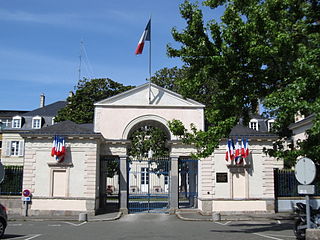
Étampes is a commune in the metropolitan area of Paris, France. It is located 48.1 km (29.9 mi) south-southwest from the center of Paris. Étampes is a sub-prefecture of the Essonne department.
Communauté d'agglomération de Laval is the communauté d'agglomération, an intercommunal structure, centred on the city of Laval. It is located in the Mayenne department, in the Pays de la Loire region, western France. It was created in 2001. Its population was 99,851 in 2014, of which 52,935 in Laval proper.

The arrondissement of Laval is an arrondissement of France in the Mayenne department in the Pays de la Loire region. Since the March 2016 reorganization of the arrondissements of Mayenne, it has 34 communes.

The Church of St Eustache, Paris is a church in the 1st arrondissement of Paris. The present building was built between 1532 and 1632.
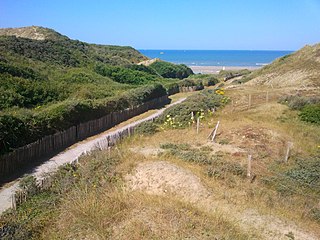
Saint-Étienne-au-Mont is a commune in the Pas-de-Calais department in the Hauts-de-France region of France near Boulogne-sur-Mer. Besides the main settlement Saint-Étienne-au-Mont, the commune consists of the two smaller settlements Pont-de-Briques and Écault.

The Roman Catholic Diocese of Laval is a Roman Catholic Latin Rite diocese in France. The episcopal see is Laval Cathedral in the city of Laval. Created in June 1855, the diocese was originally erected from the Diocese of Le Mans, and corresponds to the department of Mayenne. Under the Ancien Régime the diocese of Mans had an Archdeacon of Laval, whose responsibilities extended over the deaneries of Ernée, Évrun, Laval and Mayenne. The diocese is a suffragan of the Archdiocese of Rennes, Dol, and Saint-Malo.

Le Cailar is a commune in the Gard department in southern France. It is located at the confluence of the River Vistre and the River Rhôny. It was an important port during the Iron Age at a time when lagoons connected to the Mediterranean Sea covered the adjoining low-lying land.
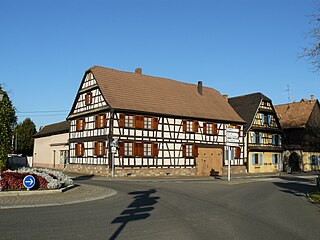
Boofzheim is a commune in the Bas-Rhin department in Grand Est in north-eastern France. Its name is probably derived from the French "bœuf". Variants of the name include Boofi - Boffesheim - Bofftsheim - Boffsheim - Bototzheim - Booftzheim - Booffzheim.

Gilles de la Pommeraie, French diplomat and Baron d'Entrammes.
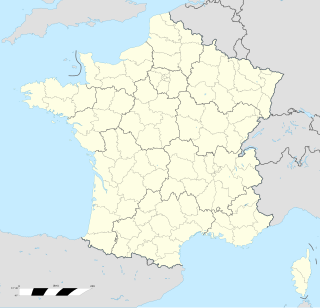
Vienne-le-Château is a commune in the Marne department in north-eastern France.

Lempdes is a commune in the Puy-de-Dôme department in Auvergne in central France.

Étienne Martellange was a French Jesuit architect and draftsman. He travelled widely in France as an architect for the Jesuit order and designed more than 25 buildings, mostly schools and their associated chapels or churches. His buildings reflect the Baroque style of the Counter-Reformation and include the Chapelle de la Trinité in Lyon and the church of Saint-Paul-Saint-Louis in Paris. In the course of his travels he made almost 200 detailed pen drawings depicting views of towns, buildings and monuments. These pictures have survived and provide an important historical record of French towns in the first third of the 17th century.
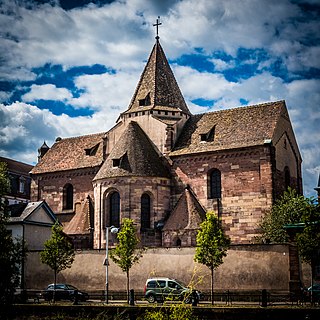
Saint Stephen’s Church in Strasbourg is located inside the catholic ‘Saint-Étienne’ college in Strasbourg, for which it serves as a chapel.
Église Saint-Étienne may refer to a number of churches in France:
The canton of L'Huisserie is an administrative division of the Mayenne department, northwestern France. It was created at the French canton reorganisation which came into effect in March 2015. Its seat is in L'Huisserie.
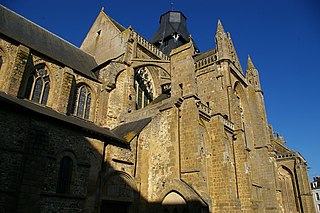
Évron Abbey is a former Benedictine abbey in Évron, in the Mayenne department in France. Its foundation is ascribed to the 7th century. It was dissolved in 1791 during the French Revolution. The former monastic church survived intact, and is now the Basilica of Notre-Dame de l'Épine.
Pierre Corbineau was a French architect, a member of a family of French architects: the Corbineau. They are found simultaneously in Anjou and in the Comté de Laval.


